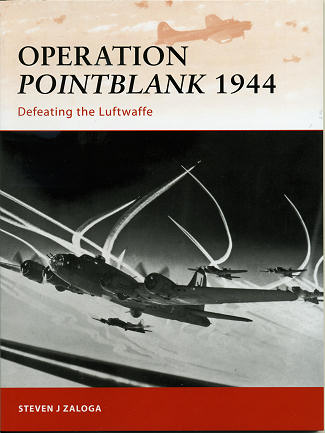 The
Allies knew that before Europe could be invaded from the UK, the Luftwaffe had
to be contained. The British had long ago given up daylight precision bombing
preferring to use the less accurate carpet bombing of German cities during the
night. This was after early war raids during the day were disastrous for the RAF
in terms of bomber losses. With no fighter protection, the Luftwaffe fighters
were able to knock down bombers at an unsustainable rate for the RAF.
The
Allies knew that before Europe could be invaded from the UK, the Luftwaffe had
to be contained. The British had long ago given up daylight precision bombing
preferring to use the less accurate carpet bombing of German cities during the
night. This was after early war raids during the day were disastrous for the RAF
in terms of bomber losses. With no fighter protection, the Luftwaffe fighters
were able to knock down bombers at an unsustainable rate for the RAF.
When the USAAF came into the picture in 1943, missions started out small and
close to the English Channel. The Luftwaffe did not have the fighter density at
that time that it would have later on, and so few US bombers were lost to
fighters. It seemed that daylight missions were possible with only heavily armed
bombers. But this was not to last.
It was decided that the best way to stop the Luftwaffe was to
destroy those industries that helped to make aircraft. Initially that was ball
bearings and the disasterous Schweinfurt raid of 1943 showed that more was
needed in terms of fighter protection. However, the only two planes available
were inadequate. The P-47 did not have the range and the P-38 was only a
mediocre fighter. Developing drop tanks helped with the range situation, but it
was still not enough. It wasn't until the P-51 Mustang started trickling in
during early 1944 that the combination of good range and a quality fighter were
met.
Meanwhile, the bombing only temporarily slowed down fighter
production by the Germans. Aircraft assembly plants were bombed with some
success. What really worked well, however, was allowing US fighters to freely
roam away from the bombers and seek out the German fighters. Strafing their
fields on the way home also was also helpful. While German aircraft production
still increased, the loss of trained pilots was devastating. So was the switch
to bombing oil production facilities. No fuel, no quality training, and easy to
shoot down German planes. It also helped that both USAAF bomber and fighter
units continued to grow and grow where the Germans could barely keep up with
attrition.
Steven Zaloga tells us the full story of the US bombing
campaign; its successes and its setbacks during this critical time. He
tells us both the
origins of the campaign as well as the events of the days that followed. A
detailed look at the leaders involved, their plans and the men they had
available to them are covered. All of this is superbly illustrated by an unknown
artist whose well drawn maps and action pieces really bring a lot of life to the
book. Of course, you get the usual batch of superb period photographs, some of
which (the book cover image, for instance) are well known to help illustrate the
book. Unlike other books, there is no look at the battlefield today as it took
place in the sky. While there are many Allied memorials to the air war, there
are few German ones. Few aircraft that participated in this operation are left
today with most extant 'WWII' planes being late war or post war vintage that
have been repainted to represent famous types.
I have to say that I found this to be a fascinating
read that I can highly recommend to you.
August 2011
For more on the complete line of Osprey books,
visit www.ospreypublishing.com. In the US, it is
Osprey Direct at 44-02 23rd St, Suite 219, Long Island City, NY 11101., where you can
get a catalogue of available books.
If you would like your product reviewed fairly and fairly quickly, please contact the editor or see other details in the Note to
Contributors.
 The
Allies knew that before Europe could be invaded from the UK, the Luftwaffe had
to be contained. The British had long ago given up daylight precision bombing
preferring to use the less accurate carpet bombing of German cities during the
night. This was after early war raids during the day were disastrous for the RAF
in terms of bomber losses. With no fighter protection, the Luftwaffe fighters
were able to knock down bombers at an unsustainable rate for the RAF.
The
Allies knew that before Europe could be invaded from the UK, the Luftwaffe had
to be contained. The British had long ago given up daylight precision bombing
preferring to use the less accurate carpet bombing of German cities during the
night. This was after early war raids during the day were disastrous for the RAF
in terms of bomber losses. With no fighter protection, the Luftwaffe fighters
were able to knock down bombers at an unsustainable rate for the RAF.